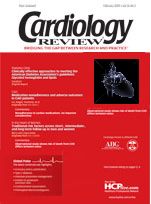Publication
Article
Cardiology Review® Online
Case report: Chest pain relief by nitroglycerin
A 54-year-old man with a history of hypertension and a family history of coronary artery disease (CAD) presented to the emergency department with intermittent chest pain over the previous 6 hours. He characterized the pain as squeezing, substernal, lasting for 5 to 15 minutes at a time, and not clearly related to exertion. He had no history of CAD, and the only medication he was taking was an angiotensin-converting enzyme inhibitor for hypertension.
While in the ambulance, the patient had an episode of chest pain, which he rated at an intensity of 8 on a 10-point scale. He was given a sublingual nitroglycerin tablet by the ambulance crew, and 5 minutes later, he rated his chest pain as 1 on the same scale. In the emergency department, his electrocardiogram (ECG) was normal, and the results of his first set of cardiac enzyme tests were negative. Because of his moderate risk profile, the patient was admitted to the telemetry unit on the medical floor, with a provisional diagnosis of “rule out myocardial infarction [MI].” He said he had had a large meal before the onset of the chest pain, but reported that he did suffer from “heartburn,” and his current pain was unlike that of heartburn. Serial enzyme tests and ECGs showed that the patient had not had an MI, and he was discharged the following afternoon with a diagnosis of gastrointestinal chest pain. He underwent a stress test the following week and completed 9 minutes 15 seconds of the Bruce protocol, without any symptoms or electrocardiographic changes.
The patient had no further episodes of chest pain during the 4 months following his admission. Although he received chest pain relief with nitroglycerin during his initial presentation, he was not diagnosed with active CAD.
